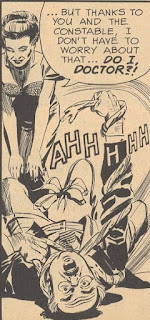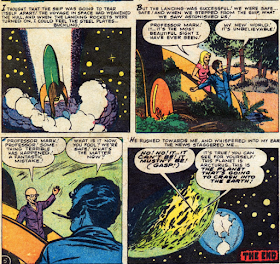 In Maurice Baudin Jr.'s short story, "The End of Indian Summer," which was published in the April 1945 issue of Esquire, a clerk at the Triumphant Insurance Company inadvertently discovers three similar claims filed by Marguerite Gillespie, a retired high school French teacher. Every few years, she married a retired man who unexpectedly died while they were on their honeymoon. Each of the three unfortunate husbands was quickly cremated.
In Maurice Baudin Jr.'s short story, "The End of Indian Summer," which was published in the April 1945 issue of Esquire, a clerk at the Triumphant Insurance Company inadvertently discovers three similar claims filed by Marguerite Gillespie, a retired high school French teacher. Every few years, she married a retired man who unexpectedly died while they were on their honeymoon. Each of the three unfortunate husbands was quickly cremated.Mr. Rogers, an investigator in the Triumphant claim department, is sent to check up on Mrs. Gillespie at her current home in Lafayette. Pretending to be a businessman, Rogers makes inquiries around town about the widow and recognizes a stranger as another insurance claims investigator; Rogers assumes the company sent another man to keep an eye on him.
 |
| Steve Forrest as Joe Rogers |
The next morning, the other detective tells Rogers that Mrs. Gillespie and Mr. Raymond left town in a hurry. The other detective reveals himself to be Saunders, from Reliable Insurance Company; he was investigating Raymond, who had at least six wives drown in the bathtub on their honeymoon and who collected life insurance on them all! The detectives wonder who will die first--the bride or the groom.
 |
| Gladys Cooper as Marguerite Gillespie |
The author of the story, Maurice Baudin Jr., has seven short stories listed in the FictionMags Index, all but one published in the slicks between 1945 and 1947. IMDb lists two TV shows adapted from his stories, including this one. He appears to have edited several collections of short stories for students and he may be the same Maurice Baudin who taught creative writing at New York University and whose students included Joseph Heller. He may have died in 1982, though a birth year of 1918 suggested in one online source seems unlikely, assuming he was teaching writing at NYU in the 1940s. It's possible there was a father named Maurice Baudin who taught and a son who wrote, but I have been unable to confirm this.
 |
| James Gleason as Howard Fieldstone |
As often happened, the screenwriter had to take long, narrative passages from the story and turn them into dialogue between characters on screen. The show begins with an establishing shot, the camera swooping up the side of a tall city building as jaunty music plays on the soundtrack to suggest the fast-moving world of business. There is a dissolve to a close up of a paperweight on a desk; the paperweight bears the logo of Triumphant Insurance Co. We sees claims manager Sam Henderson talking on the phone at his desk; he says, "'No, I'm not going to fire him--not yet'" as Joe Rogers walks into the office and overhears the end of the phone conversation.
 |
| Philip Coolidge as Sam Henderson |
 |
| Kathleen Maguire as Helen Rogers |
 Joe and Helen then visit a real estate office and ask if the Gillespie home is for sale; inexplicably, Joe insists on visiting Mrs. Gillespie alone, without his wife. He does so and finds Mrs. Gillespie to be a somewhat older woman than the one described in the story; she admits that she is "'house proud'" and she is delighted to show off her home to the stranger. The scene between Joe and Mrs. Gillespie features a shot of the sort that often appears in episodes directed by Robert Stevens--the camera is placed in a low position, looking up at the characters, with an inanimate object positioned in the foreground to draw our attention. The object this time is a teapot and, as the widow serves tea to her guest, we wonder if this is how she poisoned her husbands.
Joe and Helen then visit a real estate office and ask if the Gillespie home is for sale; inexplicably, Joe insists on visiting Mrs. Gillespie alone, without his wife. He does so and finds Mrs. Gillespie to be a somewhat older woman than the one described in the story; she admits that she is "'house proud'" and she is delighted to show off her home to the stranger. The scene between Joe and Mrs. Gillespie features a shot of the sort that often appears in episodes directed by Robert Stevens--the camera is placed in a low position, looking up at the characters, with an inanimate object positioned in the foreground to draw our attention. The object this time is a teapot and, as the widow serves tea to her guest, we wonder if this is how she poisoned her husbands.Coincidentally, Mrs. Gillespie takes this opportunity to discuss the loss of her two bridegrooms. At this point, Howard Fieldstone arrives (he was there already in the story) and asks Joe if he wants to buy the house. They had been keeping their wedding plans a secret but Howard is anxious to tie the knot.
 After some amusing dialogue among Joe, Marguerite, and Howard, Joe opens the front door to find the other investigator waiting on the porch and Joe gives him the cold shoulder. Another interesting shot follows in the next scene, as Joe brushes his teeth before a hotel room mirror and we see Helen, sitting up in bed, reflected in the glass. She comments that Joe always feels protective and sentimental toward old folks, but when a bellhop brings a telegram the mood changes: it's a report from the home office that Mrs. Gillespie has requested a $50,000 life insurance policy on Mr. Fieldstone.
After some amusing dialogue among Joe, Marguerite, and Howard, Joe opens the front door to find the other investigator waiting on the porch and Joe gives him the cold shoulder. Another interesting shot follows in the next scene, as Joe brushes his teeth before a hotel room mirror and we see Helen, sitting up in bed, reflected in the glass. She comments that Joe always feels protective and sentimental toward old folks, but when a bellhop brings a telegram the mood changes: it's a report from the home office that Mrs. Gillespie has requested a $50,000 life insurance policy on Mr. Fieldstone.Cavanagh adds another new scene where Joe and Helen sit together in the hotel dining room and discuss the lack of proof that Mrs. Gillespie has done anything wrong. The other investigator is stationed at a nearby table and Howard Fieldstone wanders in. Joe introduces him to Helen, suggesting that Fieldstone looks healthy and surely could pass an insurance physical. Fieldstone diverts suspicion by commenting that he has no use for insurance but he and Marguerite both passed physical exams that morning, at her insistence. He mentions that other people are interested in buying his fiancee's house and that the wedding is imminent.
 |
| Hal K. Dawson as the real estate agent |
James P. Cavanagh's script for "The End of Indian Summer" succeeds in taking a very short story that has little dialogue and turning it into an entertaining short film with plenty of interaction between characters. Adding Sam Henderson, Joe's boss, strengthens the credibility of Joe's belief that the other investigator is watching him; in the short story, this was something that had no foundation. Joe's wife, Helen, gives him someone to talk to when he is investigating Mrs. Gillespie; unfortunately, she is forced to miss key scenes, and thus her character's function is less clear. By expanding the character of Howard Fieldstone, Cavanagh makes the surprise ending even more delightful, since both the male and female murderers have been presented as charming characters.
Robert Stevens (1920-1989) does another fine job with the episode's direction; he clearly sets the scene twice with establishing shots and uses unusual camera placement more than once to increase visual interest and to suggest menace that is not evident in the dialogue. Stevens directed 49 episodes of the Hitchcock series, including "Place of Shadows."
 |
| Ned Wever as Saunders |
Dame Gladys Cooper (1888-1971) shines as Marguerite Gillespie; born in London, she began acting on stage as a teenager and started her film career in the silent era. After juggling stage and film roles for decades, she focused mainly on film after 1940 and began to appear on TV in 1950. She appeared three times on the Hitchcock show, including "What Really Happened," and she also was on The Twilight Zone and The Outer Limits. Hitchcock cast her in Rebecca (1940). She was made a Dame in 1967 and kept acting until the year she died.
 |
| Mike Kuhn as the bellhop |
Giving personality to an underwritten role is Kathleen Maguire (1925-1989) as Joe's wife, Helen. She appeared almost exclusively on TV from 1949 to 1981, including three episodes of Alfred Hitchcock Presents.
Philip Coolidge (1908-1967), who appeared in a total of seven episodes of the Hitchcock series, plays Sam Henderson, Joe's boss. He was on screen from 1947 to 1967 and had a part in North By Northwest (1959).
In smaller roles:
- Hal K. Dawson (1896-1987) as the real estate agent; he played bit parts on screen from 1930 to 1980 and also was seen in the Alfred Hitchcock Presents episode, "You Got to Have Luck."
- Ned Wever (1899-1984) as Saunders, the other investigator; he was a star on radio in the 1930s and 1940s and played Dick Tracy. He was on screen from 1955 to 1968 and appeared in three episodes of Alfred Hitchcock Presents, including "The Night the World Ended." He also had success as a songwriter.
- Mike Kuhn (1932- ) as the bellhop; as Mickey Kuhn, he played children in classic films such as Gone With the Wind (1939) and Red River (1948). His career petered out in the 1950s and he appeared in his final film in 1956. He was on TV three times, all in 1957 episodes of Alfred Hitchcock Presents, and then he left show business.
Read "The End of Indian Summer" for free online here. Watch the TV version online here or order the DVD here. Read the Genre Snaps take on this episode here.
Sources:
Baudin, Maurice. "The End of Indian Summer." Esquire, Apr. 1945, pp. 54–55, 151.
"The End of Indian Summer." Alfred Hitchcock Presents, season 2, episode 22, CBS, 24 Feb. 1957.
The FictionMags Index, www.philsp.com/homeville/FMI/0start.htm.
Grams, Martin, and Patrik Wikstrom. The Alfred Hitchcock Presents Companion. OTR Pub., 2001.
Heller, Joseph, and Adam J. Sorkin. Conversations with Joseph Heller. Univ. Press of Mississippi, 1993.
Hoffman, Mary. At Home Anywhere. New Rivers Press, 2010.
IMDb, IMDb.com, www.imdb.com/.
"Ned Wever." Dick Tracy Depot, dicktracy.info/people/ned-wever/.
Wikipedia, Wikimedia Foundation, 24 Nov. 2018, www.wikipedia.org/.
In two weeks: One More Mile to Go, starring David Wayne!






















































